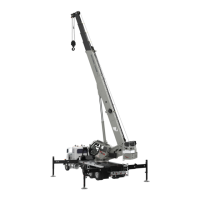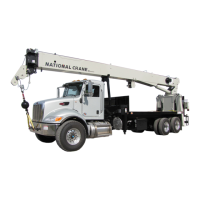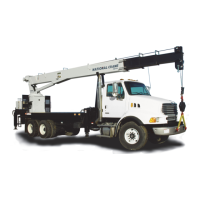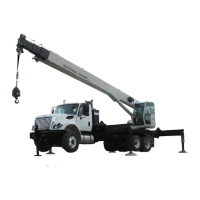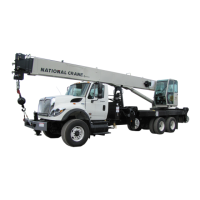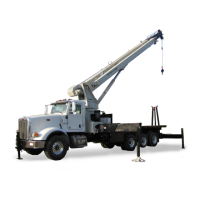CONTROLS AND OPERATING PROCEDURES OPERATOR MANUAL NTC55
3-20 Published 9-26-2018 Control # 646-02
Anti-two Block Check
Check the anti-two block alarm light and the audible alarm by
lifting the anti-two block weight until the switch is activated.
To check the anti-two block switch, do one of the following:
• manually lift the weight.
• slowly raise the hoist cable.
• slowly extend (telescope) the boom.
• with the load block close to the A2B switch weight and
the boom at 70° boom angle, slowly lower the boom.
If the crane is equipped with a jib that is deployed and rigged
for work, repeat the test procedure for the jib anti-two block
switch.
RCL Check
Perform the following checks to verify proper RCL operation.
• Check that the display of the main boom length agrees
with the actual boom length.
• Check that the display of the main boom angle agrees
with the actual boom angles.
• Check that the display of the operating radius of the
crane agrees with the actual radius.
Check the load display by lifting a load of known weight. The
accuracy of the load indication shall be within the tolerance
of SAE J159.
HOIST SYSTEM OPERATION
The Hoist may have lifting capabilities greater than that of the
crane limits. Therefore, care must be taken to ensure that the
load lifted is within the crane rating. General rules for hoist
operation are:
• Unwind the hoist when extending the boom.
• Use the anti-two-block system only as an aid.
• Make sure the rope is not twisted or kinked and that it is
properly seated in the hoist and in sheaves.
• Always have at least three full wraps of wire rope and
eight full wraps of synthetic rope on the hoist.
• Check the hoist brake when approaching the load limit of
the hoist. Raise the load a few inches and return the
control to neutral to check the brake.
• Do not drag the load with the hoist.
• Do not try to lift loads that are not free such as, frozen
down material or poles.
• Keep tension on the rope to prevent it from becoming
twisted, kinked, or improperly seated on the hoist.
WORK SITE LOCATION
Select a location that is firm, level, and dry. Avoid uneven,
rocky or muddy terrain, steep grade or locations with
overhead obstructions. The outrigger jacks must be
supported on a firm level surface at the fully retracted,
mid-span, or fully extended positions. Avoid overhead power
lines.
Before Leaving the Truck Cab
• Position the truck so that the outriggers can be extended
with no obstructions.
• Position the truck transmission to neutral.
• Set the truck park brake. Wheel chocks may also be
required.
• Engage the power takeoff.
• Turn the truck cab ignition switch to OFF.
DANGER
The following tests must be performed with caution to
prevent damage to the machine or injury to personnel.
DANGER
If the light and audible alarm do not function and the hoist
does not stop, the system is not working properly and
must be corrected before operating the crane.
DANGER
A deviation between displayed and actual values
indicates a malfunction and a RCL service representative
shall be called for repair and/or recalibration of RCL
system.
DANGER
Truck must be in neutral with the park brake set before
starting engine from crane cab to avoid sudden potential
movement of truck.
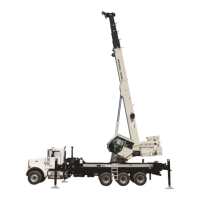
